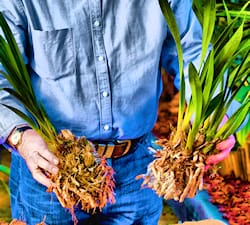
Many growers are eager to divide multi-growth plants to share, sell, or as a way to add to their collection. While those certainly are valid reasons to do so, if you can handle the size, I recommend that you not. Why? Because a larger plant is more vigorous and resilient, and capable of putting on a better show.
In my article “Support the Reserves“, I explain that plants have three basic functions, maintenance (staying alive), adding tissue (growth), and reproduction (blooming), with that being the order of priority for resource expenditure.
“Resources” is a general term that incorporates the uptake and storage of water & nutrients and the absorption of photons, resulting in the production of phytochemicals that are the building blocks and fuel for plant life.
The consumption of resources to stay alive is pretty constant on a per-growth basis. A plant with two, equal-sized growths requires twice the resources that a single-growth plant does. A plant that is not growing, but “just sitting there” is likely taking up and producing resources more-or-less equal to what it consumes, having no excess to store. A plant that is losing its yellowing lower leaves is consuming more than it is producing, so must resorb those found within its own tissues.
To grow, the plant must produce “extra” resources. Some of that must be stored in the plant before new growth will be initiated, and more is needed that can be dedicated to adding tissue and keeping the new growth alive. That new growth adds to the resource production through its roots and foliage, helping counter-balance the expenditure of growth.
Blooming and reproduction is similar in the requirement for “stored” resources to initiate and proceed with growth, but consumes a great deal of the plant’s resources without contributing much – yes, green inflorescences photosynthesize, but that’s a relatively small contribution in the overall balance.
So let’s look at a few scenarios with some simple, hypothetical math with those resource production and consumption factors, all assuming well-grown plants that are “happy” with their culture. The table below list arbitrary “resource factor Units” per function to demonstrate the concepts.
Function | Trigger Level | Production | Consumption | Net |
Maintenance | 0 | 11 | 10 | 1 |
Add Tissue | 15 | 6 | 20 | -5 |
Reproduction | 25 | 1 | 15 | -14 |
Example 1: Single-growth plant. In this case, the plant is producing 11 “resource units” per time frame, while it consumes 10, leaving a net surplus of 1 unit. As it take 15 stored units before a plant is ready to add a new growth, it will be 15 time units until it has stored enough to do so.
Example 2: Four-growth plant. This plant is producing 44 resource units per time frame, while it consumes 40, leaving a net surplus of 4 units. Again, if 15 units are required to trigger a new growth, it will be less than 4 time units until that happens – a lot sooner than for that single-growth plant.
Example 3: Four-growth plant adding a growth. Looking at the “Add tissue” row of the chart, we see that the plant had to reach 15 stored units before starting the process. As the growth adds cells, it will start generating more resources more slowly than an already-mature growth, so let’s say it socks away 6 units by the time it is mature. At the same time, 20 resource unit have been consumed, creating those tissues and fueling the chemical reactions needed to maintain them. So the “resource storeroom accounting” says we started with 15 units, added 6, but consumed 20, leaving us with a net gain of 1 unit. But now, this is a five-growth plant producing 55 units and consuming 50 per unit time, meaning it now is building resources faster and has an even shorter time frame before adding new growth or flowering.
Flowering has an even larger “trigger threshold” to begin, and certainly consumes more resources than it produces, but being of less overall mass than a new growth, that’s somewhat reduced.
I think these examples make it pretty clear why so-called “specimen plants” – those with many, many growths, giving the colony greater capacity for resource production and storage – tend to also be the best performers, often blooming multiple times a year with many blossoms and lots of new growths.